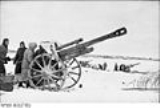
10.5 cm leFH 18M
Encyclopedia
The 10.5 cm leFH 18M ( "light field howitzer") was a German light howitzer
used in the Second World War. The gun, less the carriage and shield, was also used as the armament of the SdKfz 124 Wespe self-propelled artillery
vehicle.
as the standard German divisional
field howitzer used during the Second World War. It was designed and developed by Rheinmetall
after the war broke out in an effort to get more range from the basic leFH 18 design. A muzzle brake
was fitted and the recoil system adjusted to allow the use of a more powerful charge and new long-range shell. Generally it did not equip independent artillery battalions until after the Battle of Stalingrad
in 1943. 53 were also exported to Finland, where they were known as 105 H 33.
and retained their original wood-spoked or pressed steel wheels. The former were only suitable for horse traction. Initially, it was fitted with a single-baffle muzzle brake of relatively low efficiency. This was later improved by welding two protruding ears to the rear of the port. However this style of muzzle brake proved troublesome with the early designs of fin-stabilized
and discarding-sabot
shells and a new cage-type muzzle brake was designed and fitted.
The new FH Gr Fern long-range shell was about 25 millimetre (0.984251968503937 in) longer than the normal shells used by the leFH 18 guns, but had a shorter streamlined section behind the driving band
to accommodate the larger powder charge required. This fit in the standard cartridge case, but protruded about 50 millimetres (2 in) past its mouth.
Ballistically, the 10.5 cm leFH 18M and the leFH 18/40 are identical.
Howitzer
A howitzer is a type of artillery piece characterized by a relatively short barrel and the use of comparatively small propellant charges to propel projectiles at relatively high trajectories, with a steep angle of descent...
used in the Second World War. The gun, less the carriage and shield, was also used as the armament of the SdKfz 124 Wespe self-propelled artillery
Self-propelled artillery
Self-propelled artillery vehicles are combat vehicles armed with artillery. Within the term are covered self-propelled guns and rocket artillery...
vehicle.
History
The 10.5 cm leFH 18M superseded the 10.5 cm leFH 1810.5 cm leFH 18
-History:The 10.5 cm leFH 18 was the standard divisional field howitzer used by the Wehrmacht during the Second World War. It was designed and developed by Rheinmetall in 1929-30 and entered service with the Wehrmacht in 1935. Generally it did not equip independent artillery battalions until...
as the standard German divisional
Division (military)
A division is a large military unit or formation usually consisting of between 10,000 and 20,000 soldiers. In most armies, a division is composed of several regiments or brigades, and in turn several divisions typically make up a corps...
field howitzer used during the Second World War. It was designed and developed by Rheinmetall
Rheinmetall
Rheinmetall AG is a German automotive and defence company with factories in Düsseldorf, Kassel and Unterlüß. The company has a long tradition of making guns and artillery pieces...
after the war broke out in an effort to get more range from the basic leFH 18 design. A muzzle brake
Muzzle brake
Muzzle brakes and recoil compensators are devices that are fitted to the muzzle of a firearm or cannon to redirect propellant gases with the effect of countering both recoil of the gun and unwanted rising of the barrel during rapid fire...
was fitted and the recoil system adjusted to allow the use of a more powerful charge and new long-range shell. Generally it did not equip independent artillery battalions until after the Battle of Stalingrad
Battle of Stalingrad
The Battle of Stalingrad was a major battle of World War II in which Nazi Germany and its allies fought the Soviet Union for control of the city of Stalingrad in southwestern Russia. The battle took place between 23 August 1942 and 2 February 1943...
in 1943. 53 were also exported to Finland, where they were known as 105 H 33.
Description
Many were converted from the 10.5 cm leFH 1810.5 cm leFH 18
-History:The 10.5 cm leFH 18 was the standard divisional field howitzer used by the Wehrmacht during the Second World War. It was designed and developed by Rheinmetall in 1929-30 and entered service with the Wehrmacht in 1935. Generally it did not equip independent artillery battalions until...
and retained their original wood-spoked or pressed steel wheels. The former were only suitable for horse traction. Initially, it was fitted with a single-baffle muzzle brake of relatively low efficiency. This was later improved by welding two protruding ears to the rear of the port. However this style of muzzle brake proved troublesome with the early designs of fin-stabilized
Kinetic energy penetrator
A kinetic energy penetrator is a type of ammunition which, like a bullet, does not contain explosives and uses kinetic energy to penetrate the target....
and discarding-sabot
Armour-piercing discarding sabot
Armour-piercing discarding sabot is a type of kinetic energy projectile fired from a gun to attack armoured targets. APDS rounds are sabot rounds and were commonly used in large calibre tank guns, but have now been superseded by armour-piercing fin-stabilized discarding sabot projectiles in such...
shells and a new cage-type muzzle brake was designed and fitted.
The new FH Gr Fern long-range shell was about 25 millimetre (0.984251968503937 in) longer than the normal shells used by the leFH 18 guns, but had a shorter streamlined section behind the driving band
Driving band
The driving band or rotating band is part of an artillery shell, a band of soft metal near the middle of the shell, typically made of gilding metal, copper or lead...
to accommodate the larger powder charge required. This fit in the standard cartridge case, but protruded about 50 millimetres (2 in) past its mouth.
Ballistically, the 10.5 cm leFH 18M and the leFH 18/40 are identical.
External links
- http://www.wlhoward.com/id1074.htm Ordnance Technical Intelligence Museum Webpage
- http://www.germanwarmachine.com/weapons/artillery/lefh18.htm

